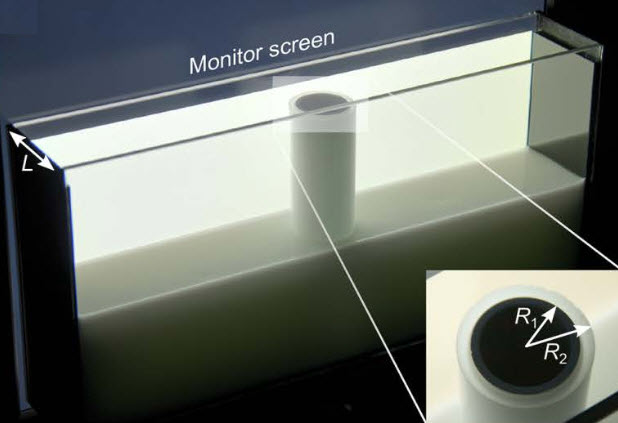How to build an optical invisibility cloak for a diffusive medium
June 9, 2014

In a diffusive light-scattering medium like this tank, a normal object (inner cylinder indicated by R1) casts a shadow, but adding a light-scattering transparent coating (R2) forms an invisibility cloak (credit: R. Schittny / KIT)
Invisibility cloaks can’t make objects fully invisible in all directions, colors, and polarizations, but Karlsruhe Institute of Technology (KIT) physicists have developed a workaround: an ideal invisibility cloak for diffusive light-scattering media, such as fog.
Their results are published in the journal Science.
In diffusive media, light is scattered by the particles in the medium. Examples are fog, clouds, or frosted glass panes that let the light in, but hide the light source. “This property of light-scattering media can be used to hide objects inside,” says Robert Schittny, first author of the study.
The experiment
In the experiment, Schittny used an extended light source to illuminate a Plexiglas tank from the back. The tank, a full centimeter in width, was filled with a white, turbid liquid. Objects inside cast a visible shadow onto the tank wall.
Simple metal cylinders or spheres of a few centimeters in diameter were used as test objects. To hide them, they were first coated with a white dispersion paint, reflected light in a diffusive (all directions) manner. To pass the light around the object, the researchers applied a thin shell made of the transparent silicon material PDMS, to which a certain concentration of light-scattering melamine microparticles was added.
The silicon/melamine shell caused a quicker diffusion of light than in its environment, so it passed the light around the objects and no longer cast a shadow. “Disappearance of the shadow indicates successful cloaking,” Schittny said.
The study was funded by the DFG Center for Functional Nanostructures (CFN) and represents pure fundamental research to demonstrate the principle.
“We will have to wait a long time for real applications,” Schittny said. “But … it might be possible to produce frosted glass panes for bathrooms with integrated [invisible] metal bars or sensors [to deter] burglary.”
Abstract of Science paper
In vacuum, air, and other surroundings supporting ballistic light propagation according to Maxwell’s equations, invisibility cloaks which are macroscopic, three-dimensional, broadband, passive, and that work for all directions and polarizations of light, are not consistent with the laws of physics. We show that the situation is different for surroundings leading to multiple light scattering according to Fick’s diffusion equation. We have fabricated cylindrical and spherical invisibility cloaks made of thin shells of polydimethylsiloxane (PDMS) doped with melamine-resin microparticles. The shells surround a diffusively reflecting hollow core, in which arbitrary objects can be hidden. We find good cloaking performance in a water-based diffusive surrounding throughout the entire visible spectrum and for all illumination conditions and incident polarizations of light.